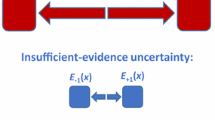Abstract
Induction of predictive models is one of the most frequent data mining tasks. However, for several domains, the available data is unlabeled and the generation of a class label for each instance may have a high cost. An alternative to reduce this cost is the use of active learning, which selects instances according to a criterion of relevance. Diverse sampling strategies for active learning, following different paradigms, can be found in the literature. However, there is no detailed comparison between these strategies and they are usually evaluated for only one classification technique. In this paper, strategies from different paradigms are experimentally compared using different learning algorithms and datasets. Additionally, a multiclass hypothesis space search called SG-multi is proposed and empirically shown to be feasible. Experimental results show the effectiveness of active learning and which classification techniques are more suitable to which sampling strategies.
Access this chapter
Tax calculation will be finalised at checkout
Purchases are for personal use only
Preview
Unable to display preview. Download preview PDF.
Similar content being viewed by others
References
Abe, N., Mamitsuka, H.: Query learning strategies using boosting and bagging. In: Shavlik, J.W. (ed.) ICML, pp. 1–9. Morgan Kaufmann (1998)
Angluin, D.: Queries and concept learning. Machine Learning 2(4), 319–342 (1987)
Attenberg, J., Provost, F.J.: Why label when you can search?: alternatives to active learning for applying human resources to build classification models under extreme class imbalance. In: KDD, pp. 423–432. ACM (2010)
Bache, K., Lichman, M.: UCI repository of machine learning databases. Machine-readable data repository, University of California, Department of Information and Computer Science, Irvine, CA (2013)
Bouckaert, R.R., Frank, E.: Evaluating the replicability of significance tests for comparing learning algorithms. In: Dai, H., Srikant, R., Zhang, C. (eds.) PAKDD 2004. LNCS (LNAI), vol. 3056, pp. 3–12. Springer, Heidelberg (2004)
Cohn, D.A., Atlas, L.E., Ladner, R.E.: Improving generalization with active learning. Machine Learning 15(2), 201–221 (1994)
Dasgupta, S.: Two faces of active learning. Theoretical Computer Science 412(19), 1767–1781 (2011)
Demsar, J.: Statistical comparisons of classifiers over multiple data sets. Journal of Machine Learning Research 7, 1–30 (2006)
Domingos, P., Hulten, G.: Mining high-speed data streams. In: Ramakrishnan, R., Stolfo, S.J., Bayardo, R.J., Parsa, I. (eds.) KDD, pp. 71–80. ACM (2000)
Fujii, A., Inui, K., Tokunaga, T., Tanaka, H.: Selective sampling for example-based word sense disambiguation. Computational Linguistics 24(4), 573–597 (1998)
Guo, Y., Greiner, R.: Optimistic active-learning using mutual information. In: Veloso, M.M. (ed.) IJCAI, pp. 823–829 (2007)
Guo, Y., Schuurmans, D.: Discriminative batch mode active learning. In: Platt, J.C., Koller, D., Singer, Y., Roweis, S.T. (eds.) NIPS. Curran Associates, Inc. (2007)
Guyon, I., Cawley, G.C., Dror, G., Lemaire, V.: Results of the active learning challenge. In: Active Learning and Experimental Design @ AISTATS, vol. 16, pp. 19–45. JMLR.org (2011)
Hall, M., Frank, E., Holmes, G., Pfahringer, B., Reutemann, P., Witten, I.H.: The WEKA data mining software: an update. SIGKDD Explorations 11(1), 10–18 (2009)
Hart, P.E.: The condensed nearest neighbor rule (corresp.). IEEE Transactions on Information Theory 14(3), 515–516 (1968)
Körner, C., Wrobel, S.: Multi-class ensemble-based active learning. In: Fürnkranz, J., Scheffer, T., Spiliopoulou, M. (eds.) ECML 2006. LNCS (LNAI), vol. 4212, pp. 687–694. Springer, Heidelberg (2006)
Kubat, M., Holte, R.C., Matwin, S.: Learning when negative examples abound. In: van Someren, M., Widmer, G. (eds.) ECML 1997. LNCS, vol. 1224, pp. 146–153. Springer, Heidelberg (1997)
Lewis, D.D.: A sequential algorithm for training text classifiers: Corrigendum and additional data. SIGIR Forum 29(2), 13–19 (1995)
Lewis, D.D.: Naive (bayes) at forty: The independence assumption in information retrieval. In: Nédellec, C., Rouveirol, C. (eds.) ECML 1998. LNCS, vol. 1398, pp. 4–15. Springer, Heidelberg (1998)
Lin, J.: Divergence measures based on the shannon entropy. IEEE Transactions on Information Theory 37(1), 145–151 (1991)
McCallum, A., Nigam, K.: Employing EM and pool-based active learning for text classification. In: Shavlik, J.W. (ed.) ICML, pp. 350–358. Morgan Kaufmann (1998)
Melville, P., Mooney, R.J.: Diverse ensembles for active learning. In: Proceedings of the Twenty-First International Conference on Machine Learning, p. 74. ACM, New York (2004)
Mitchell, T.M.: Machine learning. McGraw Hill Series in Computer Science. McGraw-Hill (1997)
Quinlan, J.R.: C4.5: Programs for Machine Learning. Morgan Kaufmann (1993)
Raghavan, H., Madani, O., Jones, R.: Active learning with feedback on features and instances. Journal of Machine Learning Research 7, 1655–1686 (2006)
Ritter, G.L., Woodruff, H.B., Lowry, S.R., Isenhour, T.L.: An algorithm for a selective nearest neighbor decision rule (corresp.). IEEE Transactions on Information Theory 21(6), 665–669 (1975)
Robertson, A.: The sampling variance of the genetic correlation coefficient. Biometrics 15(3), 469–485 (1959)
Roy, N., McCallum, A.: Toward optimal active learning through sampling estimation of error reduction. In: Brodley, C.E., Danyluk, A.P. (eds.) ICML, pp. 441–448. Morgan Kaufmann (2001)
Schein, A.I., Ungar, L.H.: Active learning for logistic regression: an evaluation. Machine Learning 68(3), 235–265 (2007)
Settles, B.: Curious machines: active learning with structured instances. Ph.D. thesis, University of Madison Wisconsin (2008)
Settles, B.: Active Learning. Synthesis Lectures on Artificial Intelligence and Machine Learning. Morgan & Claypool (2012)
Settles, B., Craven, M.: An analysis of active learning strategies for sequence labeling tasks. In: EMNLP, pp. 1070–1079. ACL (2008)
Settles, B., Craven, M., Ray, S.: Multiple-instance active learning. In: Platt, J.C., Koller, D., Singer, Y., Roweis, S.T. (eds.) NIPS. Curran Associates, Inc. (2007)
Shannon, C.E.: Communication theory of secrecy systems. Bell System Technical Journal 28(4), 656–715 (1949)
Author information
Authors and Affiliations
Editor information
Editors and Affiliations
Rights and permissions
Copyright information
© 2014 Springer International Publishing Switzerland
About this paper
Cite this paper
dos Santos, D.P., de Carvalho, A.C.P.L.F. (2014). Comparison of Active Learning Strategies and Proposal of a Multiclass Hypothesis Space Search. In: Polycarpou, M., de Carvalho, A.C.P.L.F., Pan, JS., Woźniak, M., Quintian, H., Corchado, E. (eds) Hybrid Artificial Intelligence Systems. HAIS 2014. Lecture Notes in Computer Science(), vol 8480. Springer, Cham. https://doi.org/10.1007/978-3-319-07617-1_54
Download citation
DOI: https://doi.org/10.1007/978-3-319-07617-1_54
Publisher Name: Springer, Cham
Print ISBN: 978-3-319-07616-4
Online ISBN: 978-3-319-07617-1
eBook Packages: Computer ScienceComputer Science (R0)




